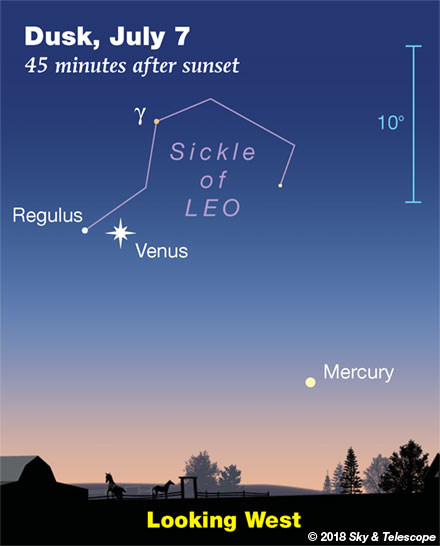
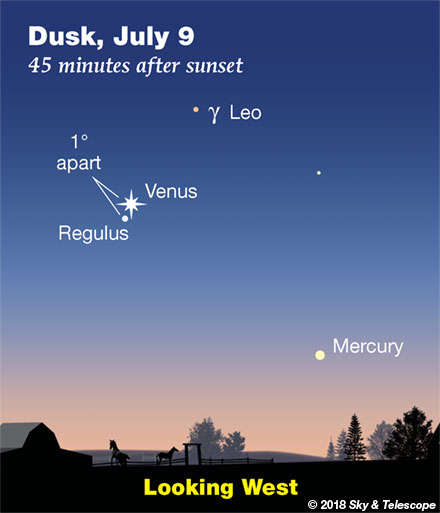
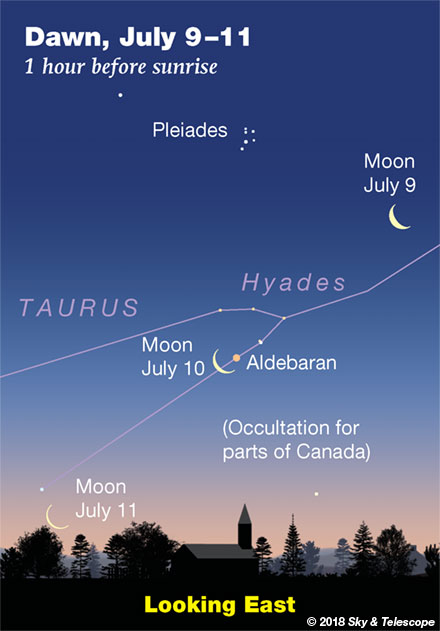
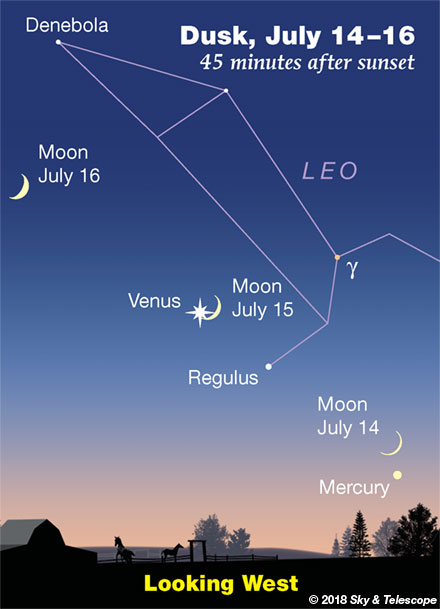
Friday, July 6
• As twilight fades, watch for Regulus coming into view 3½° to the left of Venus, as shown here.
• After dark the central stars of the constellation Lyra, forming a small triangle and parallelogram, dangle to the lower right from bright Vega high in the east. The two brightest stars of the pattern, after Vega, are the two forming the bottom of the parallelogram: Beta and Gamma Lyrae, Sheliak and Sulafat. They're currently lined up vertically. Beta is the one on top.
• Earth is at the aphelion of its orbit today, its farthest from the Sun for the year: 3% farther than at perihelion in January.
Saturday, July 7
• After dark, Altair shines in the east-southeast. It's the second-brightest star in the eastern sky, after Vega high to its upper left. Above Altair by a finger-width at arm's length is little orange Tarazed. A bit more than a fist-width lower left of Altair is little Delphinus, the Dolphin, leaping leftward.
Sunday, July 8
• The Big Dipper, high in the northwest after dark, is beginning to turn around to "scoop up water" through the evenings of summer and early fall.
Monday, July 9
• Venus and Regulus are in conjunction, 1° apart in the western twilight. Watch for Regulus coming into view just to Venus's lower left.
• Last occultation of Aldebaran. Early Tuesday morning, the thin waning crescent Moon will occult 1st-magnitude Aldebaran for parts of Canada and the uppermost Midwest. The line of grazing occultation crosses Wisconsin and the Straits of Mackinac on to Labrador. The rest of North America sees a near miss. Local timetables. See also Bob King's article Don’t Miss Aldebaran’s Last Occultation Till 2033.
Writes David Dunham, organizer of the International Occultation Timing Association,
"The brightest star (other than the Sun) that can be occulted by the Moon will be occulted one last time during the current series, for observers in the western Great Lakes region. It will be a good event, with the crescent Moon only 11% sunlit, so those with clear skies might see the reappearance [of Aldebaran on the Moon's dark limb] even without optical aid. But the Moon will be low; you will need an unobstructed horizon in the east-northeast where the Moon will rise."
Special webpage for this event, with detailed maps.
Not until 2033 will we get another good Aldebaran occultation. Continues Dunham, "The 19-year period between series of occultations of the same star [including the Sun] is called a Meton cycle; the series of occultations of Aldebaran last about 4 years. Four Meton cycles ago, the last accessible Aldebaran graze of that series occurred on March 12, 1962. That was the first grazing occultation I tried to predict, using printed tables of trig functions and a clunky Marchant calculator.... I got close enough [to the graze line] to see Aldebaran's angular size when it reappeared, appearing like a drop of water coming out of a faucet. That sparked my lifelong interest in pursuing these events, precipitating the start of a worldwide effort to observe them."
Tuesday, July 10
• If you have a dark enough sky, the Milky Way now forms a magnificent arch high across the eastern heavens after nightfall is complete. It runs all the way from below Cassiopeia in the north-northeast, up and across Cygnus and the Summer Triangle in the east, and down to the south behind Saturn and the spout of the Sagittarius Teapot.
Wednesday, July 11
• The Cygnus Milky Way is high in the east after dark and passes overhead late at night. The Heart Star of Cygnus, and the center of the Northern Cross, is 2nd-magnitude Sadr (Gamma Cygni), smack in the Milky Way's midst. Binoculars will show the roughly heart-shaped ring of faint stars around and including it. Explore this area with Matt Wedel's Binocular Highlight column and chart in the July Sky & Telescope, page 43.
Thursday, July 12
• Three doubles at the top of Scorpius. The head of Scorpius — the nearly vertical row of three stars upper right of Antares — stands highest in the south right after dark, about two fists at arm's length to the left of bright Jupiter. The top star of the row is Beta (ß) Scorpii or Graffias, a fine double star for telescopes.
Just 1° below or lower left of it (a fingertip at arm's length) is the very wide naked-eye pair Omega1 and Omega2 Scorpii, not quite vertical. Binoculars show their slight color difference.
Upper left of of Beta by 1.6° is Nu Scorpii (Jabbah), another fine telescopic double. Or rather triple. High power in good seeing reveals that Nu's brighter component is itself a close binary, separation 2 arcseconds.
• New Moon (exact at 10:48 p.m. Eastern Daylight Time).
Friday, July 13
• Cassiopeia is now well past its annual bottoming out due north. Look for its W pattern climbing low in the north-northeast after dark. The farther north you live, the higher it will be.
Saturday, July 14
• As twilight fades, see if you can catch the Moon over Mercury very low in the west, well to the lower right of Venus as shown above. Your best view may be about 45 minutes after sunset.
• One hour after sunset, as twilight fades further and the stars are coming out, you'll find the two brightest stars of summer, Vega and Arcturus, about equally near the zenith: Vega toward the east, shining a very pale bluish white, and Arcturus toward the southwest, shining pale yellow-orange.
________________________
Want to become a better astronomer? Learn your way around the constellations! They're the key to locating everything fainter and deeper to hunt with binoculars or a telescope.
This is an outdoor nature hobby. For an easy-to-use constellation guide covering the whole evening sky, use the big monthly map in the center of each issue of Sky & Telescope, the essential guide to astronomy.

Once you get a telescope, to put it to good use you'll need a detailed, large-scale sky atlas (set of charts). The basic standard is the Pocket Sky Atlas (in either the original or Jumbo Edition), which shows stars to magnitude 7.6.
Next up is the larger and deeper Sky Atlas 2000.0, plotting stars to magnitude 8.5; nearly three times as many. The next up, once you know your way around, are the even larger Interstellarum atlas (stars to magnitude 9.5) and Uranometria 2000.0 (stars to magnitude 9.75). And read how to use sky charts with a telescope.
You'll also want a good deep-sky guidebook, such as Sue French's Deep-Sky Wonders collection (which includes its own charts), Sky Atlas 2000.0 Companion by Strong and Sinnott, or the bigger Night Sky Observer's Guide by Kepple and Sanner.
Can a computerized telescope replace charts? Not for beginners, I don't think, and not on mounts and tripods that are less than top-quality mechanically (meaning heavy and expensive). And as Terence Dickinson and Alan Dyer say in their Backyard Astronomer's Guide, "A full appreciation of the universe cannot come without developing the skills to find things in the sky and understanding how the sky works. This knowledge comes only by spending time under the stars with star maps in hand."
This Week's Planet Roundup
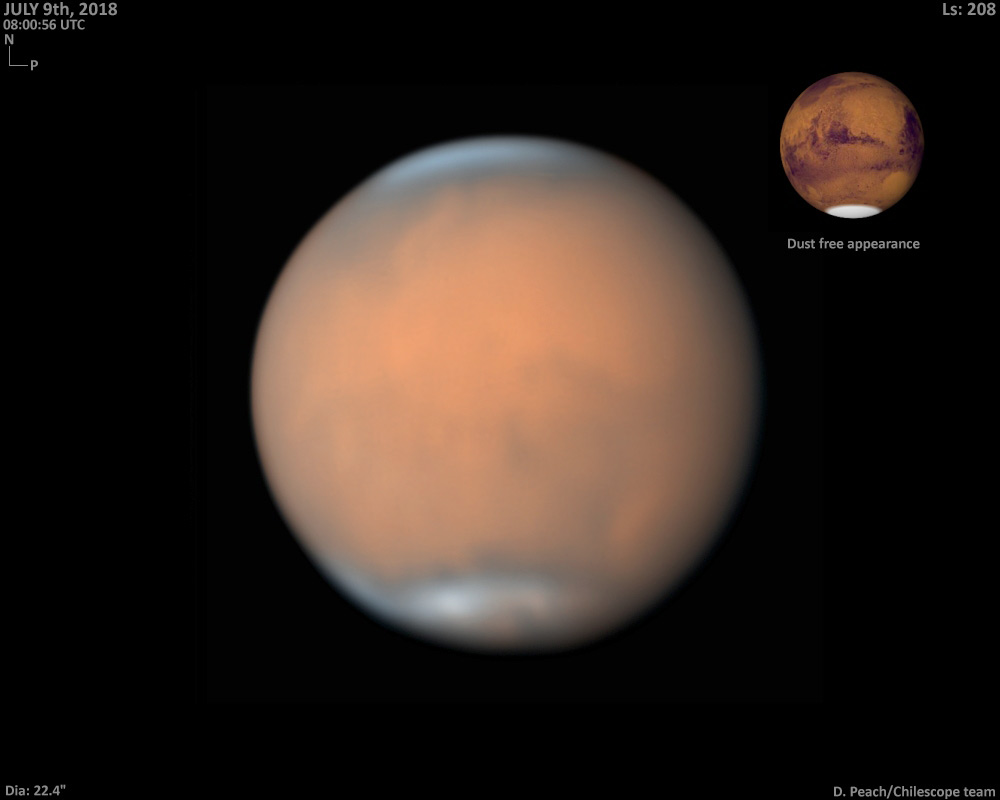
North is up.
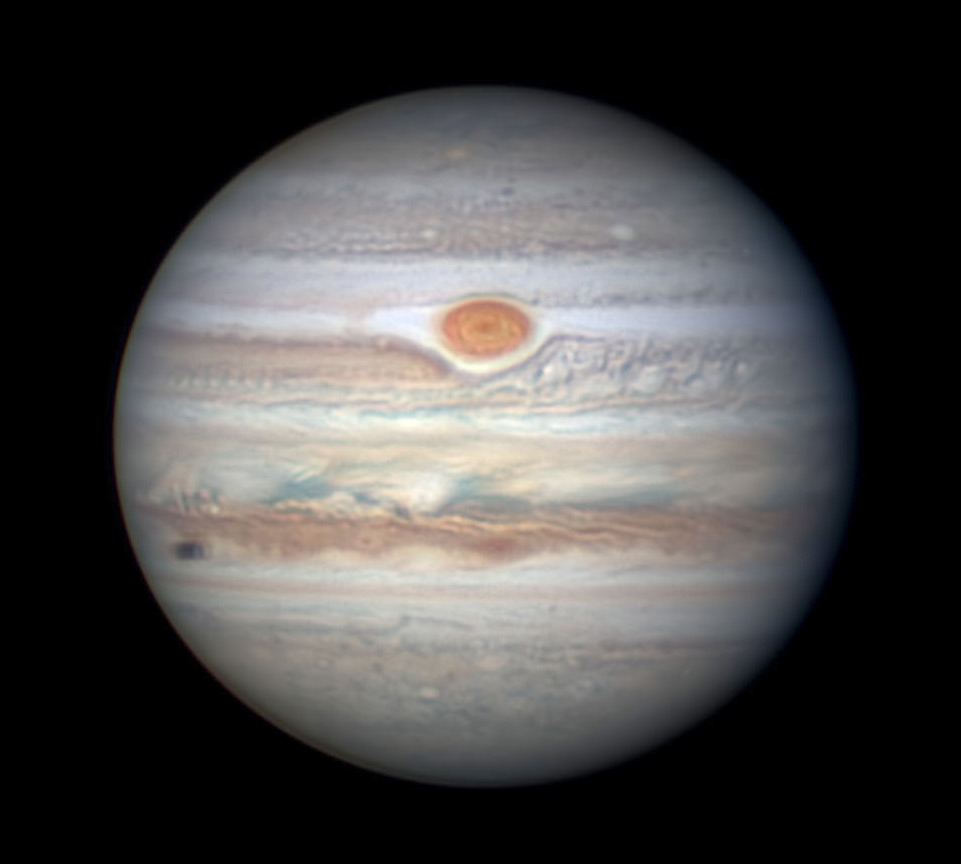
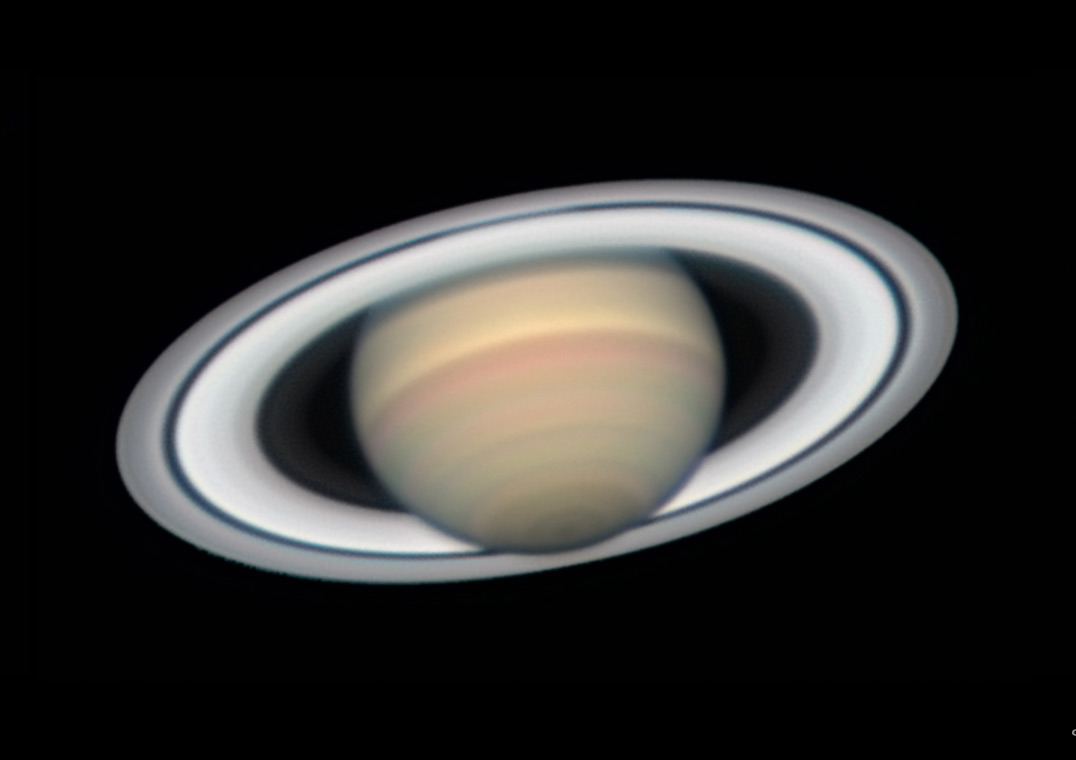
Mercury (about magnitude +0.2) is visible in bright twilight very low in the west-northwest, about 16° lower right of Venus. Catch Mercury in the narrow time window between when the sky is still too bright and when Mercury sinks too low and sets.
Venus (magnitude –4.1, in Leo) shines brightly in the west during twilight, a trace lower every day. In a telescope Venus is a gibbous disk 17 arcseconds tall and 67% sunlit.
This week Venus passes Regulus, which glimmers less than 1% as bright. On July 7th Regulus is still 3½° to Venus's left or upper left. They're in conjunction on Monday the 9th, with Regulus 1° to Venus's south (lower left). By July 16th it's 4½° to Venus's lower right.
Mars is the "star" planet of the summer! It's now a dramatic, Jupiter-bright magnitude –2.4, rising in southern Capricornus in late twilight. Mars is highest in the south, in best telescopic view, in the two hours hour before the first light of dawn. It's 22 arcseconds in diameter, on its way to 24.3 arcseconds around its closest approach on the night of July 30-31.
But Mars is in the throes of a great dust storm! Dust has enveloped the globe, obscuring most dark surface features and reducing contrast for the rest. "The planet is unrecognisable," wrote imager Damian Peach on June 26th. The dust is expected to remain in the atmosphere and hide most of the surface right through opposition and well after. See our article Big Dust Storm Blows up on Mars, updated several times.
Can you identify any of the usual markings as seen in your scope? You'll want a Mars map that shows which features are facing Earth at your time and date, such as our Mars Profiler online.
Vesta, the brightest asteroid, is still about magnitude 5.9 in southern Ophiuchus about 10° west of Saturn. Article and finder charts: Vesta Gets Close and Bright.
Jupiter (magnitude –2.3, in Libra) shines in the south-southwest in twilight and declines in the southwest later in the evening. This week it shrinks from 41 to 40 arcseconds wide. See our telescopic guide to observing Jupiter in the May Sky & Telescope, page 48.
Saturn (magnitude +0.1, just above the Sagittarius Teapot) glows in the southeast in twilight and higher in the south by midnight. It's 34° to the upper right of much brighter Mars.
Uranus (magnitude 5.8, at the Aries-Pisces border) and Neptune (magnitude 7.9, in Aquarius) are well up in the east and southeast, respectively, in the hour before the beginning of dawn. Finder charts for Uranus and Neptune.
______________________
All descriptions that relate to your horizon — including the words up, down, right, and left — are written for the world's mid-northern latitudes. Descriptions that also depend on longitude (mainly Moon positions) are for North America.
Eastern Daylight Time (EDT) is Universal Time (also called UT, UTC, GMT, or Z time) minus 4 hours.
______________________
"Remember to look up at the stars and not down at your feet. Try to make sense of what you see and wonder about what makes the universe exist. Be curious."
— Stephen Hawking, 1942–2018
______________________
"The dangers of not thinking clearly are much greater now than ever before. It's not that there's something new in our way of thinking, it's that credulous and confused thinking can be much more lethal in ways it was never before."
— Carl Sagan, 1996
______________________
"Objective reality exists. Facts are often determinable. Vaccines save lives. Carbon dioxide warms the globe. Bacteria evolve to thwart antibiotics, because evolution. Science and reason are not a political conspiracy. They are how we determine facts. Civilization's survival depends on our ability, and willingness, to do this."
— Alan MacRobert, your Sky at a Glance editor
______________________
"Facts are stubborn things."
— John Adams, 1770
 0
0








Comments
You must be logged in to post a comment.